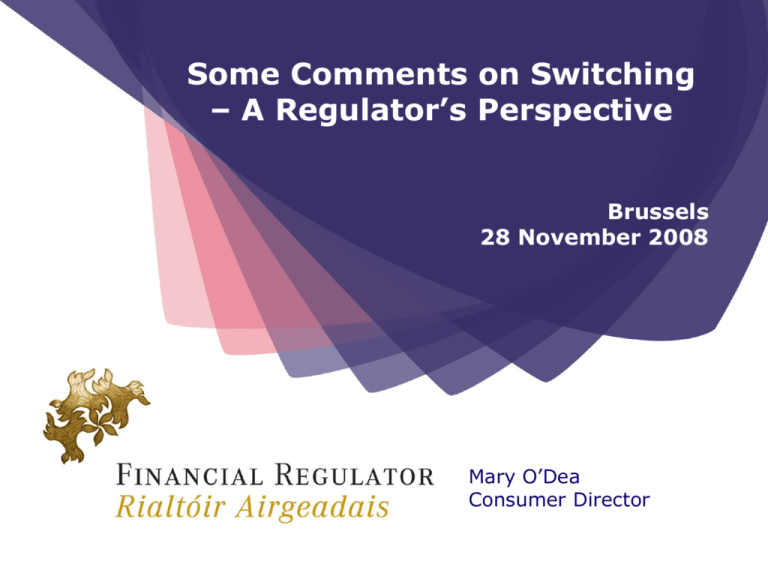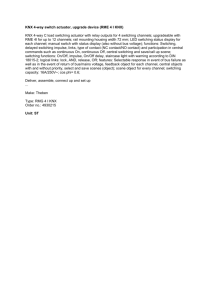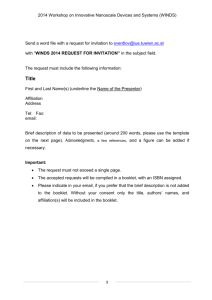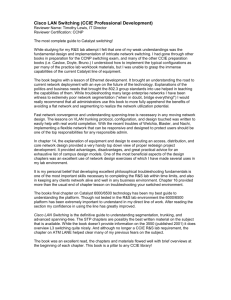How to overcome the endowment effect and encourage consumers
advertisement

Some Comments on Switching – A Regulator’s Perspective Brussels 28 November 2008 Mary O’Dea Consumer Director Who we are and what we do: We are a statutory regulator, responsible for the supervision and regulation banks, insurance companies (life and general), investment managers, stockbrokers, retail intermediaries and credit unions. Our role is to help consumers make informed decisions on their financial affairs in a safe and fair market, and to foster sound and solvent financial institutions. Role of Consumer Director: Includes: Setting and Enforcing Standards: Issuing consumer protection rules/ requirements; Informing: Providing information to consumers on the costs, risks and benefits of financial products and services; Advocating: Promoting greater transparency, access and competition in retail financial markets. Link to Competition Policy: The Financial Regulator and the Irish Competition Authority are required, by statute, to pursue consistent policies. Personal Current Account Switching: The Financial Regulator plugged switching as important; We were an observer on an industry group that developed a switching code; September 2005 - Irish Competition Authority recommended that Financial Regulator monitor the (then) newly introduced industry current account switching code. Operation of the Switching Code: Features of the Code: All participating banks must open new accounts, set up payment instructions and provide cards, etc., to customers within 10 working days. They also must close old accounts, transfer balances, and notify the new bank and third parties such as utilities paid by direct debit, within 7 working days. Business Current Account Switching Code Introduced in July 2006; Fundamentally similar to the personal current account switching code. We monitor the Code by: Analysing Statistics submitted by the industry; Conducting Mystery Shopping exercises; Attendance at the meetings of an industry technical group dealing with switching issues; and Monitoring queries received via our consumer helpline. Current view: Still too early to say; Switching levels look low compared to other EU jurisdictions – however caution must be exercised in relation to comparing data; EU-wide statistics (with a harmonised methodology) might be helpful? We also promote price transparency: In order to help consumers compare financial products and services we publish cost comparisons on our personal finance website: www.itsyourmoney.ie. Most popular views: Lump-sum deposits; Credit Cards; Regular savings products; Current accounts; Personal loans; Motor insurance; Home insurance; Life insurance. We promote these surveys through the media, via press releases and articles Recent data on shopping around: Product: Percentage that had shopped around in the last 5 years: Mortgage 65% General Insurance (e.g. motor, home etc.) 53% Investment Product 39% Life Assurance 39% Credit Card 29% Savings Account 24% Loan 18% Current Account 17% Study of Credit Cards in Ireland (2007) Some facts about the Irish market: 13 card issuers active in the market; 99.7 % of all credit cards issued are either branded Visa (59.3%) or Mastercard (40.4%) Interest rates range from 9.5 % to 18.9 %; The three largest card issuers enjoying a market share of 78.6 per cent; These three issuers are at the upper end of the range of rates charged in the market. Question: How can such a high price differential be sustained in the market, i.e. why don’t consumers cancel their highinterest cards and take out low-interest cards instead? Our suggested answers: Many consumers are not aware of the interest rate applied to credit card balances (and consequently are not aware that better value may be had in the market); The credit card issuers do not compete strongly on the ongoing interest rate charged. They offer “balancetransfer” deals instead; Consumers may have an irrationally optimistic view of the likelihood that they will incur interest rate charges; Consumers may overestimate the degree of difficulty involved in switching from one credit card provider to another; Some consumers only use their credit cards as a convenient payment method and not to borrow. For these consumers the interest rate charged is irrelevant. Some regulatory initiatives in Ireland (1): Our Consumer Protection Code prohibits unsolicited pre- approved credit facilities. Rationale: Some consumers will always spend up to the limit on their credit card or overdraft facility. (Seems consistent with the idea of “asymmetrical paternalism” – i.e. helps boundedly rational consumers to avoid costly mistakes but imposes little costs on rational consumers.) Some regulatory initiatives in Ireland (2): Renewal notices for home and motor insurance: Insurance companies are required to send a reminder notice to consumers 3 weeks ahead of the renewal date. The notice must give the consumers the information they need to shop around. We considered requiring a longer notice period, (say 6 weeks) however, we believed that a longer notice period would be less effective, because when a deadline is distant the need for action is less urgent. Endowment Effect and Consumer Protection and Education Question 1 Can an understanding of the endowment effect help regulators to better understand switching behaviour? Endowment Effect and Consumer Protection and Education Question 2 Can we use our understanding of the Endowment Effect to develop better consumer information and education policies? Limiting Consumer Choice !!! Are consumers overwhelmed by the choices they face when contemplating switching? E.g. Are there too many credit cards to chose from? (Does not necessarily equate to too many providers) Is the pricing of credit cards too complex? Does the fact that we can switch anytime mean that switching is never urgent? Do consumers intend to take action but do not because of these factors? Thank you


![Network Technologies [Opens in New Window]](http://s3.studylib.net/store/data/008490270_1-05a3da0fef2a198f06a57f4aa6e2cfe7-300x300.png)






